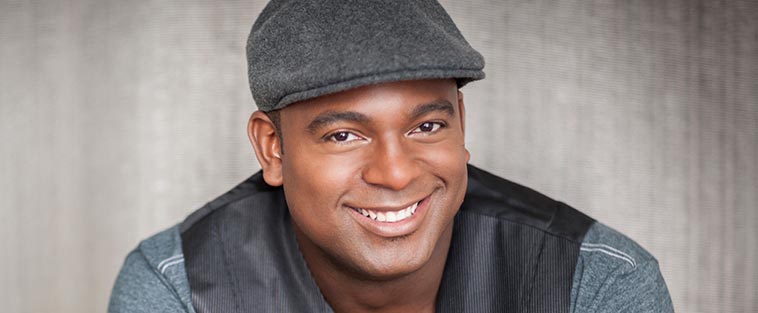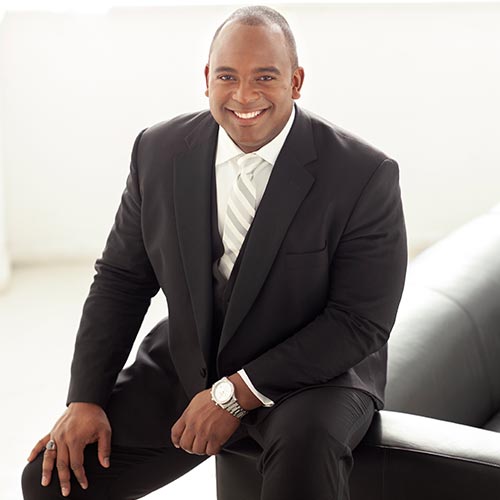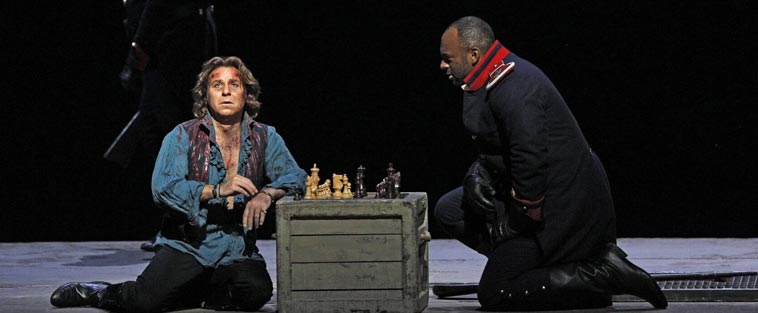
By Mark Thomas Ketterson
When Ryan Speedo Green was in fourth grade in southern Virginia, he was placed in a special education class for students with behavior problems. His teacher was Elizabeth Hughes, a petite woman with blonde wavy hair, a heart of gold, and a backbone of stainless steel. Green initiated their relationship by hurling his desk at her. Rather than reacting with expected censure, Hughes calmly told him that she could teach him as well sitting on the floor as anywhere else, and if he demonstrated an incentive to learn, she would restore the desk. He earned his desk back.
Hughes continued to encourage Green when he later became incarcerated in the juvenile detention system. Even in that bleak environment, there was hope. When allowed to have a radio, he would sing along with the Top 40 hits. It was clear to anyone within earshot that something extraordinary was going on in Green’s cell. The kid had a voice.
Green’s voice was his ticket to a newfound sense of self-worth that turned his life around. His voice took him to a magnet school for the arts, then to Hartt School of Music for his bachelor’s degree, and on to Florida State University for a Master of Music. In 2011 he was one of five winners of the Metropolitan Opera National Council Auditions and entered the Met’s Lindemann Young Artist Development Program. Last fall, 20 years after the desk incident, Mrs. Hughes attended the Met for the opening night of La bohème, in which Green sang the principal bass role of Colline. The New York Times called his performance “a show stopper.” Also a member of the Vienna State Opera, Green is juggling a demanding career throughout Europe and at the Met, not to mention with various regional companies. In the midst of that busy schedule, he will be making his Ravinia debut with a recital in the Martin Theatre on July 3.
 Green’s journey from juvenile detention to international opera is grippingly recounted in a bestseller by journalist Daniel Bergner, Sing for Your Life: A Story of Race, Music, and Family. The book is available on Amazon—order a box of Kleenex while you’re there; you’ll need it. [Bergner will be leading a discussion with Green, as well as a book signing, after the concert.] Green (“Speedo” to his friends) isn’t wasting time dwelling on his past though; the busy bass-baritone is too occupied looking at his future. Green completely obliterates the ubiquitous stereotype of young American opera singers as technically proficient but historically uninformed—the guy can talk you under the table regarding world politics, the contributions of singers over multiple generations, and on musical styles from Bellini to Berg and beyond.
Green’s journey from juvenile detention to international opera is grippingly recounted in a bestseller by journalist Daniel Bergner, Sing for Your Life: A Story of Race, Music, and Family. The book is available on Amazon—order a box of Kleenex while you’re there; you’ll need it. [Bergner will be leading a discussion with Green, as well as a book signing, after the concert.] Green (“Speedo” to his friends) isn’t wasting time dwelling on his past though; the busy bass-baritone is too occupied looking at his future. Green completely obliterates the ubiquitous stereotype of young American opera singers as technically proficient but historically uninformed—the guy can talk you under the table regarding world politics, the contributions of singers over multiple generations, and on musical styles from Bellini to Berg and beyond.
Green spoke to Ravinia from Houston Grand Opera, where he was on loan from Vienna to perform the role of Osmin in Mozart’s The Abduction from the Seraglio. That score requires the singer to plunge into seriously subterranean bass territory, down to a low D. “Some of the best Osmins in history were probably bass-baritones,” Green observes. “When Mozart wrote it, they were simply called basses. Nothing is set in stone. My age of 31 is young for lower voices. Look at Eric Owens. He was singing Sarastro [a pure bass role in The Magic Flute] and now he’s singing Scarpia [the baritone lead in Tosca]. In 10 years my voice could go higher or lower. I’m lower now, but I just sang Escamillo [the bass-baritonal toreador of Carmen] in San Antonio, and my second Colline at the Met. One of my favorite singers is Sam Ramey. Ramey sang Sarastro, but he also sang Scarpia with no effort. He calls himself a bass, yet he could sing Escamillo better than most baritones.
“When I was younger my knowledge was more limited,” Green recalls. “So I was listening to the ‘Opera 101’ singers, from Domingo to Maria Callas, Leontyne, and Pavarotti. Past college I began getting into singers who were active at the time, like Renée Fleming and Larry Brownlee and the beginnings of Marcello Giordani. At the Met I was given the rare opportunity to attend performances and absorb as much as I could. I was there every night. As I started delving into different styles, I fell in love with new singers. I heard Richard Croft in Satyagraha, my first modern opera. I heard David Daniels and the young countertenor Anthony Roth Costanzo. My range of singers kept growing. I think every person goes through different phases of opera love, unless you are born into it. Once I was able to see opera on my own I started falling in love with singers every week!
“I was privileged to have great teachers at my magnet school for the arts who first informed me about singers that were not only pivotal to opera in America but also pivotal to me as an African American. You know, singers from Marian Anderson to Jessye Norman, Leontyne Price, and Kathleen Battle, all these artists who spearheaded opera for African Americans. In college I did a semester on modern opera, which introduced me to Eric Owens in Doctor Atomic. Before high school I thought opera was something you saw in cartoons or commercials.”
It was through one of those eminent African-American artists that Green realized his life direction. On a school trip at age 15, he attended a performance of Bizet’s Carmen at the Met. The Carmen was Denyce Graves. Her presence had a profound impact on the young musician. “I realized that the title character was someone who looks like me. She was an African-American woman, and before that I never thought opera was something that people of color could do. It blew me away. I was feeling all these emotions. I never saw anything so beautiful, it was like being an astronaut your first time in space. I got to meet her backstage. It wasn’t an untouchable Beyoncé or Michael Jackson; she was a real person, like one of my mom’s friends. She took pictures with me, and called me her ‘boo.’ I left knowing I wanted to sing opera and tell stories, just like she told me a story. It made opera immediately tangible, because she was a person of color.” As they headed home, Green told his teacher that some day he too would sing at the Metropolitan Opera.
And he did.
As one among the generation of artists currently emerging into prominence, Green’s take on the state of the culture for African-American singers is instructive. “Oh, it’s a lot better, and I am an optimistic person, [but] it can always be improved. In opera, generally, we’re still having conversations about physicality; you know, this lady is too big or that lady’s too small. Preconceptions exist. So when a six-foot-five African-American singer walks into an audition,” Green muses, “is your first thought, ‘I hope it’s not a gospel sound’? Or ‘I hope he can sing in Italian, or German, or French’? When maybe if he were a six-foot-five white guy you’d be thinking of the roles he could play, not whether he can actually sing opera. These are the kind of small preconceptions that I know still exist, but the fact that we can talk about it means we can change it. I don’t think being African American makes me better than anybody, but knowing the struggles of my predecessors who blazed a path for me gives me pride and confidence. It is amazing what African Americans have accomplished in an art form that was not part of their culture, and was only open to them at the last minute when we got human rights.
“You know,” he reflects, “it hurt during my days training as a classical musician that I would sing something like Schubert’s Schwanengesang, and when I walked offstage the first thing someone would do is ask if I knew who Paul Robeson and William Warfield are and say, ‘I’d love to hear you sing “Old Man River.” ’ It was never a black person, always a white lady or guy. I would say thank you, but in my mind [I would think] I just sang Schubert, and instead of them thinking, ‘Oh, I can hear you in Brahms or Wagner,’ or at least something in the language I was singing in, they go straight to the most stereotypical thing you could possibly imagine, and something that isn’t even opera or art song. I don’t think that is respectful to me as an artist or to the art form. That’s even happened in Vienna.”
An obvious question hangs in the air—what about Gershwin’s Porgy? “Well that is considered opera,” Green warrants. “I don’t think I’m vocally or even emotionally ready to tackle something like Porgy yet. It’s a ginormous role! Honestly, I don’t want to do a role like that anytime soon because I really feel like there’s so much more opera that I could sing.”
He is, however, more than ready to join the illustrious procession of recitalists who have graced the Ravinia stage when he makes his festival debut. “I have never sung in Chicago!” Green enthuses. “So I am excited to come and sing for you! My focus is going be on German art song and songs that involve African-American poets. It’s not like there are hundreds of varieties of African-American art songs out there, but I’m going to bring those to the table. I like recitals, and lieder is very good for my voice, but unfortunately the theme of songs written for low voices is usually death. That’s a generalization, but it seems to be a cultural interpretation of the bass voice. I mean, can you think of a German opera where the bass is a happy person? I might throw a transposition of something in there just to mix it up and keep it upbeat! I [owe thanks] to David Okerlund, my teacher at Florida State, for showing me the beauty of German lieder, and Ken Noda, one of my big mentors at the Met [and one of the closest colleagues of James Levine], for broadening those horizons. My program is really a testament to them and their teachings.
“I am determined to seize every opportunity I am given to make myself a better musician, a better artist, and a better person,” Green concludes. “Opera has given me the opportunity to learn languages, to learn about other cultures. Music changed my life. For that, I have tried to do justice to it and honor it. If someone saved your life, you would always treat them with the respect and honor that person deserves. Music, to me, is like that person who saved me.”
Mark Thomas Ketterson is the Chicago correspondent for Opera News. He has also written for the Chicago Tribune, Playbill, Chicago magazine, Lyric Opera of Chicago, Houston Grand Opera, and Washington National Opera at the Kennedy Center.
